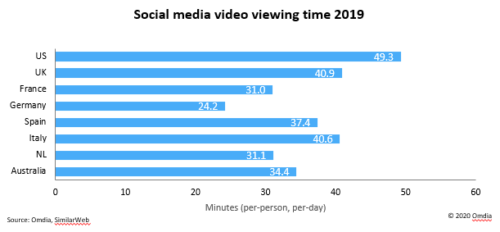Linear TV remains dominant form of television viewership in 2019
Tuesday, July 28th, 2020
LONDON — Despite declines in viewership, linear television remains the dominant form of TV viewing for consumers across the United States and other major economies, according to Omdia.
Linear TV accounted for 63 percent of television viewing in the United States in 2019, compared to 16 percent for long-form viewing and 12 percent for PVR time-shifted television, as reported by the Omdia Cross-Platform Television Viewing Time Report – 2020. Linear TV’s share of television viewing declined from 67 percent in 2018. Similar trends occurred in most of the other countries tracked by the report. The report covering television viewership trends in the United States, Australia, the Netherlands, Spain, Italy, Germany, France and the United Kingdom.
Average linear TV viewing time declined in all but one market, with decreases ranging from four minutes in Italy to 19 minutes in the United States. The Netherlands was the only market to not see a decline in linear viewing, remaining unchanged from last year.
“Although traditional linear television viewing is undergoing a broad-based decline, this form of entertainment remains central to most people’s viewing habits,” said Rob Moyser, an analyst covering television media, service providers & platforms at Omdia. “As a result, linear still accounts for the majority of viewing in all countries tracked. In some countries, linear still strongly dominates viewing, totaling 90 percent in Italy, for example.”
On the non-linear front, online long-form video is the main platform driving growth in 2019. Online long-form was a key area of growth across all markets, driven largely by online subscription video services such as Netflix and Amazon Prime. Growth of online long-form video content in 2019 ranged from 55 percent in Australia to 10 percent in the Netherlands.

Growth in over-the-top (OTT) subscribers, D2C launches, and a rise in connected TV and pay-TV partnerships are fueling the increase in online, long-term video viewing.
However, the fastest-growing segment of the non-linear view market is social media. Social media viewing across the countries tracked increased by 10 minutes in 2019, a growth rate that surpassed all other forms of non-linear television video.
The United States led social media viewing, with 49.3 minutes in 2019.
The advance of social media was partly propelled by the massive growth of Chinese video-sharing service TikTok.
“TikTok’s success was one of the breakout stories of 2019, with the social media app growing at historic rates,” Moyser said. “This rate of increase was so huge it quickly became the most popular social media platform for video viewing in Germany and the second most popular app in three other northern European countries: The United Kingdom, France and the Netherlands.”
Time spent viewing video content on social media platforms increased by 10 minutes in 2019 to an average of 41 minutes per-person per-day across the eight markets analyzed. In comparison, all other forms of non-linear viewing increased by a cumulative of seven minutes over the year.
Other developments noted by the report include:
- Average total daily viewing time for the markets analyzed rose to 306 minutes per-person, per-day in 2019, an increase of four minutes year-on-year.
- TV viewing saw a massive rise in consumption in March and April 2020 following the implementation of lockdown measures across the countries covered. Italy had the highest total for viewing time in Europe in March at five hours and 46 minutes.
- Italians spent 346 minutes a day in front of the TV screen in March 2020, an increase of 34.1 percent on the same period last year, the highest total for viewing time in Europe.
Latest News
- Barb to start reporting TV-set viewing of YouTube channels
- SAT FILM selects multi-DRM from CryptoGuard
- Qvest and ARABSAT to launch OTT streaming platform
- ArabyAds & LG Ad Solutions partner with TVekstra in Turkey
- Freeview NZ satellite TV service to move to Koreasat 6
- Comscore expands YouTube CTV measurement internationally
